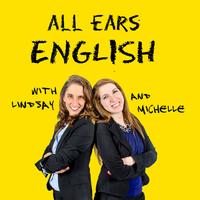81- How to Start Your Presentation in English with Three Phrases.
Lindsay: This is an All Ears English Podcast, Episode 81: “How to Start Your Presentation in English with Three Phrases.”
[Instrumental]
Gabby: Welcome to the All Ears English Podcast, where you'll finally get real, native English conversation with your hosts, Lindsay McMahon, the ‘English Adventurer' and Gabby Wallace, the ‘Language Angel,' from Boston, USA.
In this episode, you'll get three specific, practical sentences that you can use to start your presentation in English today.
[Instrumental]
Gabby: Hey Lindsay.
Lindsay: Hey Gabby. How are you feeling today?
Gabby: I'm feeling great. I'm really excited for this presentation topic. We were just talking to our friend and (uh) presentation expert, Carl Kwan on Monday.
Lindsay:
Absolutely.
Gabby:
Yeah, that was a great conversation.
Lindsay:
Yeah, it's a really important topic too because we've had a few students, (um) we had, Keiko wrote in to us and asked us for some help with presentations, so we want to address that.
Gabby:
Yeah.
Great. So we're going to give you guys our three phrases that you can use to start your presentation and these are all based on Carl's advice.
Lindsay:
Yes.
Gabby:
So we're going to give you an example because we are actually preparing a presentation.
Lindsay:
Which we're a little nervous about.
Gabby:
It's for the (um) the TESOL which is Teaching English as a second language or Teaching English to Speakers of Other Languages convention (um) out in Portland, Oregon. We'll be out there at the end of March.
Lindsay:
Yeah.
Gabby:
So we're preparing a presentation. Our audience is other English teachers. So the first thing we want to do is to connect with our audience. So we wanna (want to) give you a practical phrase but it's kind of specific because we have to give you an example, right? So how would we connect with our audience?
Lindsay:
Yeah.
How do you connect with someone, with anyone? You just find the thing that you have in common with them and then you show that you empathize with them. So you could say something like this: “We understand that technology might be a little scary and that you're looking for a new way to reach your students.” Gabby:
Yeah.
Something like “We're teachers too. We know how you feel.” Right.
Lindsay: Exactly.
Gabby:
So connecting with your audience is obviously specific to your presentation, (you know). So it's difficult to give you an exact phrase, but those are two examples that we would use in our presentation. But now the second phrase that we want to give you is totally general, you could copy and paste this exactly. “What I'm going to give you today is a solution to your problem.”
Lindsay:
And this goes back to Carl's second tip, which was to solve a problem for the audience.
Gabby;
Yeah.
Lindsay:
And to always be thinking about what their problem is. So again, what's that phrase?
Gabby:
“What I'm going to give you today is a solution to your problem.” Lindsay:
Nice.
Gabby:
Cool.
And then our third sentence and this is all in the beginning of your presentation (uh) is about a question and answer. So Lindsay what would be a phrase we can use to talk about question and answer?
Lindsay:
Yeah.
So the tip here again was don't necessarily end with the question and answer, right? So what you could say is (you know) “Please hold your questions until the end” and show them how you're going to structure the presentation.
Gabby:
Yeah.
“So please hold your questions until the end” okay. And then as Carl said, after people ask questions and you give answers, you summarize the presentation. Do not end, by saying “That's all.”
Lindsay:
And running off the stage.
Gabby:
Yeah.
Your summary is your “that's all”, right? You don't need to say it again.
Lindsay:
And the reason that we're mentioning this also is that if you're giving a presentation here in the US, (um) you might be more likely to get questions in the middle of the presentation.
Gabby:
Right.
Right.
People will jump in so that's why it's important to say in the beginning of you representation, “Please hold your questions until the end.”
Lindsay:
(Uh-huh). Perfect.
Gabby:
Awesome. So yeah, those are three phrases (um) that you can use to begin your presentation. So for example, (uh) “You're teachers, we're teachers. We know it's new and scary to use a podcast or use technology in your classroom, (uh) but, but we know how you feel.” Okay. “What we're going to give you today is a solution to, to this problem.” And “Please hold your questions until the end.” Lindsay:
Okay. So those are the three or four phrases that you need to do an awesome presentation.
Gabby:
Cool.
[Instrumental]
Gabby:
Hey Lindsay.
I heard that (um) one of your students was talking about the transcripts.
Lindsay:
Yeah.
So (um) a student of mine in Spain was saying that he is really a visual learner, so he needs to not only listen to All Ears English every day, but he also needs to see the words.
Gabby:
Yeah, that's really helpful, I think, for a lot of people to read as they listen. So yeah, we wanted to remind you that we have the transcripts available at our website, www.allearsenglish.com/conversations. And the transcripts are just the text of what you're hearing.
Lindsay:
Yeah.
Just every word that we're saying spelled out for you. So there are no secrets. You'll know exactly what you're saying, we're saying. So come on over.
[Instrumental]
Lindsay: If you want to put your ears into English more often, be sure to subscribe to our podcast in iTunes on your computer or on your smartphone. Thanks so much for listening and see you next time.

